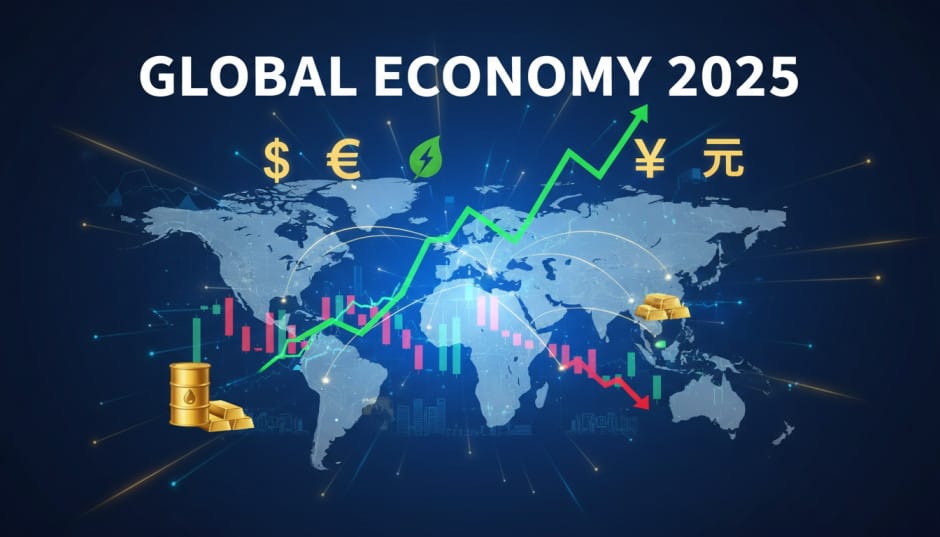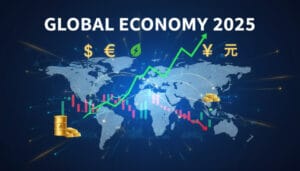Global Economy in 2025: Navigating Trade Wars, Inflation, and the Green Tech Revolution

The global economy in 2025 stands at a critical juncture, shaped by unprecedented shifts in international trade dynamics, persistent inflationary pressures, and the accelerating race for technological supremacy. As nations grapple with supply chain disruptions, currency volatility, and the ongoing transition to sustainable energy, the economic landscape has become increasingly complex and interconnected.
International Trade and Market Dynamics
The international trade environment has undergone dramatic transformation, with traditional partnerships being redefined and new alliances emerging. The United States-China trade relationship continues to evolve, moving beyond the tariff wars of previous years toward more sophisticated forms of economic competition. Both nations are now focusing on securing supply chains for critical technologies, particularly in semiconductors, artificial intelligence, and renewable energy components.
The European Union has emerged as a significant third player in this dynamic, launching ambitious trade frameworks designed to reduce dependence on both American and Chinese supply chains. The EU’s recent initiatives in green technology represent a strategic pivot toward technological sovereignty, particularly in areas such as battery manufacturing, solar panel production, and electric vehicle components.
Regional trade agreements have gained renewed importance as countries seek to diversify their economic partnerships. The Comprehensive and Progressive Agreement for Trans-Pacific Partnership (CPTPP) has expanded its membership, while the African Continental Free Trade Area (AfCFTA) has begun to show tangible results in boosting intra-African commerce. These agreements reflect a broader trend toward regionalization of trade, as nations prioritize economic security alongside efficiency.
Digital trade has become increasingly central to international commerce, with cross-border data flows now representing a significant portion of global economic activity. However, this has also created new tensions around data sovereignty, privacy regulations, and digital taxation, leading to complex negotiations within international forums.
Global Inflation and Currency Fluctuations
Inflationary pressures continue to challenge policymakers worldwide, though patterns vary significantly across regions. While some developed economies have successfully reduced inflation from pandemic-era peaks, emerging markets continue to struggle with persistent price pressures, particularly in food and energy sectors.
Central banks have adopted increasingly divergent monetary policies, creating significant currency volatility. The Federal Reserve’s policy stance continues to influence global capital flows, with emerging market currencies experiencing particular sensitivity to U.S. interest rate changes. The European Central Bank has maintained a more accommodative approach, reflecting the eurozone’s different economic challenges, while the Bank of Japan has begun to gradually shift away from its ultra-loose monetary policy.
Currency markets have been further complicated by the growing use of digital currencies and central bank digital currencies (CBDCs). Several countries have launched or are piloting CBDCs, potentially reshaping international payment systems and reducing reliance on traditional reserve currencies. China’s digital yuan has gained traction in international trade settlements, while the European Union advances its digital euro project.
The U.S. dollar’s dominance as the global reserve currency faces new challenges, though it remains resilient. Efforts to create alternative payment systems, such as those developed by BRICS nations, reflect growing desire for monetary independence, particularly among countries subject to economic sanctions.
Economic Relations and Geopolitical Tensions
Economic diplomacy has become increasingly intertwined with geopolitical considerations, as nations use trade and investment policies to advance strategic objectives. The concept of “economic security” has gained prominence, with countries implementing measures to protect critical industries and technologies from foreign influence.
Supply chain resilience has emerged as a national security priority, leading to policies promoting “nearshoring” and “friend-shoring.” This trend has benefited countries like Mexico, Vietnam, and India, which have attracted manufacturing investments as companies diversify away from concentrated production bases.
Sanctions and economic restrictions have become more sophisticated and targeted, focusing on specific sectors such as technology, energy, and finance. These measures have created complex compliance challenges for multinational corporations and have accelerated the development of alternative economic networks.
International economic cooperation faces new challenges as traditional multilateral institutions adapt to changing power dynamics. The G7 and G20 forums continue to play important roles, but their effectiveness is increasingly questioned as member countries pursue divergent economic strategies.
Energy Markets and Commodity Price Volatility
The global energy transition has fundamentally altered commodity markets, creating new winners and losers in the international economy. Oil prices remain volatile, influenced by geopolitical tensions, production decisions by OPEC+, and the accelerating shift toward renewable energy sources.
Natural gas markets have been particularly turbulent, with regional price disparities reflecting infrastructure constraints and geopolitical tensions. The development of liquefied natural gas (LNG) infrastructure has increased market flexibility but has also created new dependencies and vulnerabilities.
Critical mineral markets have emerged as a new frontier of economic competition. Lithium, cobalt, rare earth elements, and other materials essential for renewable energy technologies and electric vehicles have experienced dramatic price swings. Countries rich in these resources are leveraging their positions to secure better terms in international agreements.
Agricultural commodities continue to face pressure from climate change, trade restrictions, and changing consumption patterns. Food security has become a central concern for many nations, leading to policies that prioritize domestic production and strategic reserves.
The carbon market has matured significantly, with carbon pricing mechanisms now operational in numerous jurisdictions. This has created new trading opportunities while adding complexity to international business operations and investment decisions.
Global Financial Institutions and Governance
International financial institutions are adapting to new economic realities and evolving global priorities. The International Monetary Fund (IMF) has expanded its lending facilities and introduced new instruments to address climate change and digital transformation challenges. The institution has also begun incorporating climate risks into its surveillance activities and policy recommendations.
The World Bank has undergone significant reforms, increasing its lending capacity and focusing more heavily on climate change and sustainable development. The bank’s new approach emphasizes country-led development strategies while maintaining strong environmental and social safeguards.
Regional development banks have gained prominence as alternatives to traditional Western-led institutions. The Asian Infrastructure Investment Bank (AIIB) continues to expand its membership and lending portfolio, while the New Development Bank established by BRICS nations has increased its activities in infrastructure and sustainable development financing.
The European Union has strengthened its economic governance mechanisms, particularly in response to challenges posed by the pandemic and ongoing geopolitical tensions. The EU’s NextGenerationEU recovery fund has demonstrated the bloc’s capacity for coordinated fiscal action, while new rules on foreign investment screening reflect growing concerns about economic security.
Financial regulation has become increasingly coordinated internationally, with institutions like the Financial Stability Board (FSB) and Bank for International Settlements (BIS) playing crucial roles in addressing emerging risks from digital assets, climate change, and technological innovation.
Looking Ahead: Challenges and Opportunities
The global economy faces significant challenges in the coming years, including demographic shifts, technological disruption, and the ongoing effects of climate change. However, these challenges also present opportunities for innovation, cooperation, and sustainable growth.
The transition to a more sustainable and resilient global economy requires unprecedented levels of international cooperation and investment. Success will depend on the ability of nations and institutions to balance economic efficiency with security concerns, while ensuring that the benefits of globalization are more broadly shared.
As the world navigates these complex dynamics, the importance of multilateral cooperation and adaptive governance becomes increasingly clear. The global economy of 2025 and beyond will be shaped by how effectively the international community can address these interconnected challenges while maintaining the benefits of economic integration and technological progress.







